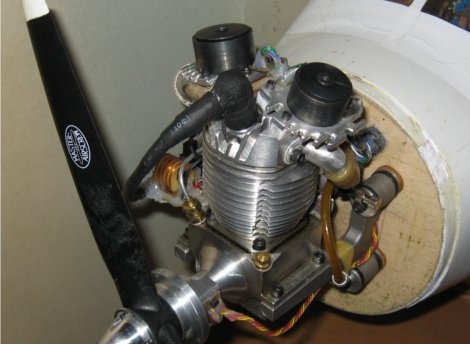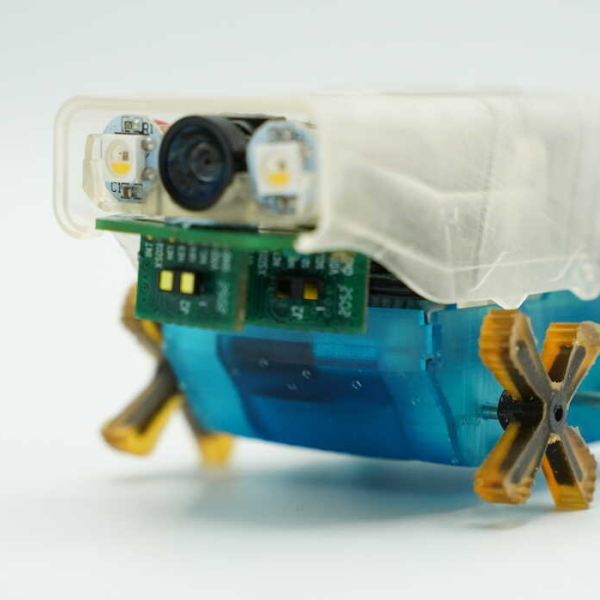

We had some interesting High Voltage posts over the past couple of weeks. Today we are announcing the next theme: Engine Hacks. Each day for the next two weeks we will be doing a new post about some sort of interesting engine project. We’ll be showing projects where engines are built from scratch, engines are modified to work in a new way, or where an engine is used in an manner that it wasn’t originally intended. If you or someone you know has an interesting project that you think might fit well within this category, please let us know through our tip line.
Pictured above is an EVIC (Electronic Valve Internal Combustion) engine. This type of engine doesn’t have a cam shaft to actuate the valves. Solenoids are used instead and are paired with a small processor and some sensors to determine when and how long to open the valves. This type of engine allows you to do things like vary the amount of fuel coming into the cylinder on a continually variable basis. If you paired this with electronic ignition, you could even make the engine run in reverse!
















fyi, would NOT recommend running a 2cycle engine in reverse! ;)
Great idea overall, would the old conversion to run on kerosene by adding an additional head gasket trick qualify?
Polaris snow mobiles run in reverse using this exact method. Even better, they can change from running forward to reverse with some tricky ignition timing.
Not just polaris, everyone with a 2-stroke sled does it :)
They spin the motor down to ~100rpm, flip the timing and just fire it up backwards.
It’s a 4 stroke from the look of things.
That said, a reed valve or rotary (loop- or cross-scavenged) 2 stroke has a “symmetrical” exhaust and intake timing about TDC/BDC. In a uniflow-scavenged 2 stroke engine, the valve timing would generally be non-symmetrical.
I think you mean 4-stroke, which technically is a 2-cycle, seeing how a cycle is a full revolution (2 strokes). Typical 4-strokes with camshafts cannot run backwards, it just won’t work. This one however could. Seeing that the valves can be opened and closed whenever the user wants, it just needs the addition of an EFI system to be able to inject fuel whenever he wants.
I have run a 4 stroke engine backwards in a Honda Accord. It was an accident. It wasn’t happy about it.
The real thing to consider when running a larger engine backwards is all the pumps spin the wrong way. Which means the water pump doesn’t really work, the oil pump is pulling oil away from the bearings, and all your accessories are confused.
I remember hearing a story about someone with a little 2 stroke car racing someone in a Porsche … lost the race of course then wanted to race in reverse! So he flipped the timing somehow and then started the car in reverse.
All in all he won b/c the Porsche has 1 gear in reverse while he had 5.
Saab 96s :) they had a 3 cylinder 2 stroke and you could bump start em backwards and have all 4 forward gears in reverse lol. they actually performed quite well going forward for only having 75hp in rally form. enough to get first or second at monte carlo in the 60s and elsewhere
Also, Im looking forward to this month. However, if the posts consist of adding tachos to engines using an arduino etc. I shall be sorely dissapointed.
Damn my dyslexic tendencies. Reading “Adding TACO’s to engines using an Arduino” produced some disturbing mental imagery.
I’d like to see some : Car engine computer hacks, some sterling engines and a good instruction on building a NXT compatible engine (yes with taco !) from a hi-torque servo.
Ow.. and jets, lots of jets.
same here!
I too would love to see stuff on turbine engines and PULSE JETS!
OBDII interfaces would be great using (insert your fav dev board here)
This is really cool and i like the idea of it. This could have a future with the electronic nature of cars now. My question is how do the solenoids hold up at high rpms? I could see both advantages and disadvantages to this system.
I remember these experiments from way back when I was in gradeschool…back then they could hardly run fast enough to idle a diesel. Today they are better…but still not exactly great. They can’t handle the RPMs of small engines (those tiny engines should be running at least twice as fast), and bigger engines need bigger valves, so they can’t handle the RPMs of big engines either.
One alternative that does work is using high pressure oil; I think Koenigsegg has a working engine using this method…all the advantages of electric activation combined with high RPMs.
Tucker had a prototype engine in 1948 that actuated the valves with a hydraulic system.
Last I checked, this design had been taken up to 14,000 RPM. I’d say the solenoids handle high speeds quite well.
yess!
model steam powered flywheel engines-go.
this.
Stirling engines! I attempted building one when I was a kid from scratch… epic failure. Easy design, minimal parts and lots of fun. Not easy for a 10 year old to do on his own. I might have to dust off the lathe and try to make one again now that I have some real-world experience.
http://hackaday.com/2005/07/02/diy-nitrous-oxide-injection/
Lol more like that^.
I hope we get a post or two with a coal- or wood-gas gasifier…
This new theme thing is great! Keep up the good work!
I have always been intrigued by the jet engine kits sold by United Nuclear
They’ve still not got back to me about international shipping though.
Build your own, maybe? http://www.junkyardjet.com/
I whole-heartedly approve of this topic. I need to use less fuel!
Looking forward to discussions of home-build EFI systems like MegaSquirt.
I’d definitely like to see a post about wood gasifiers. All in all I like this new theme idea alot.
i like this topic
F1 engines run in the same way. With electronic valves ( or in some cases pneumatic) you pretty much eliminate valve float which is crucial for an engine operating at +20,000 rpms.
As I understand it, Formula One teams have in the past used electro-hydraulic valve systems, as opposed to the project above which is electro-mechanical. At the time that Renault was experimenting with electronically controlled valves, solenoids were simply not capable of keeping up in an electro-mechanical system. Having said that, they were unable to keep up in a three-litre V10 engine reving to 20,000 RPM, and later limited to 18,000 RPM, implying that they may have been capable of operating in a more ‘normal’ engine.
http://scarbsf1.com/valves.html
F1 engines have tiny little valves that hardly open…and electric valves still couldn’t keep up, not even on a project with an unlimited budget.
All of the electrical-only camless systems I have seen so far run at about 1/2 of “consumer” engine speed, regardless of engine size.
So yeah…electrical camless would work just fine on a 1.8 liter engine that is limited to 4000RPM…but it would be a slow pig that was good for nothing but fuel efficiency, and you would never be able to make it pay for itself because the 16 solenoids would cost more than the rest of the engine, and they would burn themselves out long before they paid for themselves in fuel savings.
I would say that it was a technology of the future…but a CVT eliminates the need for a camless engine…all we need now is an auto manufacturer that will use CVTs for the whole line instead of limiting them to minivans like Nissan has done.
Regarding the reverse 2-stroke, I used to bump-start my Aprilia RS50 in reverse for a laugh.
I’ll be impressed when someone can “hack” whatever system auto manufacturers use to determine that someone has changed their ‘calibration’ tables. In other words, they have ways of finding out that a “tune” was done to a vehicle.
Turbo diesels are commonly modded/tuned to get more HP out of them. In the process, the powertrain and engine are stressed beyond manufacturer warranted specs. So they (rightly) deny warranty coverage for any damage to the tranny or engine from a contraband “tune”.
It would be interesting to know what countermeasures the designers use nowadays to detect the non-spec table being downloaded to the boxes.
I would presume ventilated pistions and/or chunks of metal in an otherwise well-designed and robust transmission would be a good indicator of abuse.
The problem is getting the manufacturer to own up to real warrantee issues when there are mods that don’t affect the system in question.
it woukd be really cool to see something done about the wankle rotary engine!
Oh hell yes, this is a great topic!
Hopefully there’ll be some good content.
Flywheel engines all the way :D
Adding some monitoring logic in addition to electronic ignition might produce quite a reliable engine for an UAV. It would also be great to switch between fuel efficient and turbo modes depending on current power requirements.
Excellent topic HAD. I’ve been reading a lot about engine mods and hacks in an effort to design a Green Hornet type car.
I’d love to see hydrostatic drivetrain designs, such as:
http://hydraulicinnovations.com/
The only topper to that would be a diesel free-piston hydraulic pumps:
http://en.wikipedia.org/wiki/Free-piston_engine
Oh well, a guy can dream…
Solar panel charging a couple batteries will be fine if you are really camping. Even with a cloudy day or two. If all you are running is lights in the evening, maybe a radio you’ll be fine. If you are actually driving a home on wheels, then you’ll need to hook up to full ac.It always baffled me why folks would pack up, go to a beautiful natural setting, then crank up a noisy, smelly generator to power their 25 TV, microwave, and vaccum cleaner. That ain’t camping.Today’s solar panels last for years (10-20), properly cared for. A simple trickle charger to keep batteries topped of can sit on your dashboard. You’ll have to determine how much you are hooking up to it to size your system. But you can get started for $60 or so.